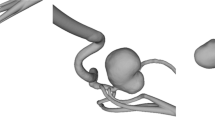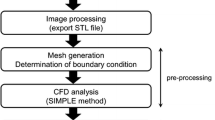Abstract
Objective
To evaluate if knowledge of patient-specific inflow data in computational fluid dynamics simulations is required for the accurate calculation of intra-aneurysmal flow patterns and wall shear stress in an aneurysm of the anterior communicating artery (AcomA).
Materials and methods
3D digital subtraction angiography (3D-DSA) and phase contrast magnetic resonance (pcMRI) images were obtained in a 71-year old patient with an unruptured aneurysm of the anterior communicating artery (AcomA). A baseline computational flow dynamics simulation was performed using inflow boundary conditions measured with pcMRI. Intra-aneurysmal flow patterns, maximum, minimum and average values of wall shear stress and wall shear stress histograms were calculated. Five additional computational flow dynamics simulations were performed, in which simulated inflow from the right and left A1 segment was varied, while keeping the total inflow constant. Intra-aneurysmal flow patterns measured with pcMRI were qualitatively compared to intra-aneurysmal flow patterns derived from the simulations.
Results
Intra-aneurysmal flow patterns calculated in the baseline simulation were in good qualitative agreement with pcMRI measurements. Intra-aneurysmal flow patterns and wall shear stress changed considerably when inflow conditions were altered. Changes in the flow distribution between right and left A1 segments caused variations of the averaged wall shear stress as high as 43%.
Conclusion
Intra-aneurysmal flow patterns and wall shear stress in an AcomA aneurysm calculated with computational flow dynamics depended strongly on the flow distribution between A1 segments. Patient-specific flow data measured with pcMRI obtained prior to computational flow dynamics are necessary for an accurate simulation of intra-aneurysmal flow patterns and calculation of wall shear stress in AcomA aneurysms. Further studies may indicate if wall shear stress calculated with computational flow dynamics can predict aneurysm growth and/or rupture.

Similar content being viewed by others
References
Acevedo-Bolton G, Jou LD, Dispensa BP, Lawton MT, Higashida RT, Martin AJ, Young WL, Saloner D (2006) Estimating the hemodynamic impact of interventional treatments of aneurysms: numerical simulation with experimental validation: technical case report. Neurosurgery 59:E429–E430 author reply E429–430. doi:10.1227/01.NEU.0000223495.39240.9A
Castro MA, Putman CM, Cebral JR (2006) Patient-specific computational fluid dynamics modeling of anterior communicating artery aneurysms: a study of the sensitivity of intra-aneurysmal flow patterns to flow conditions in the carotid arteries. AJNR Am J Neuroradiol 27:2061–2068
Catro MA, Putman CM, Cebral JR (2006) Computational fluid dynamics modeling of intracranial aneurysms: effects of parent artery segmentation on intra-aneurysmal hemodynamics. AJNR Am J Neuroradiol 27:1703–1709
Cebral JR, Castro MA, Burgess JE, Pergolizzi RS, Sheridan MJ, Putman CM (2005) Characterization of cerebral aneurysms for assessing risk of rupture by using patient-specific computational hemodynamics models. AJNR Am J Neuroradiol 26:2550–2559
Ford MD, Alperin N, Lee SH, Holdsworth DW, Steinman DA (2005) Characterization of volumetric flow rate waveforms in the normal internal carotid and vertebral arteries. Physiol Meas 26:477–488. doi:10.1088/0967-3334/26/4/013
Heuer WDC, Marusic I (2005) Turbulence wall-shear stress sensor for the atmospheric surface layer. Meas Sci Technol 16:1644–1649. doi:10.1088/0957-0233/16/8/015
Jou LD, Wong G, Dispensa B, Lawton MT, Higashida RT, Young WL, Saloner D (2005) Correlation between lumenal geometry changes and hemodynamics in fusiform intracranial aneurysms. AJNR Am J Neuroradiol 26:2357–2363
Karmonik C, Klucznik R, Benndorf G (2008) Blood flow in cerebral aneurysms: comparison of phase contrast magnetic resonance and computational fluid dynamics—preliminary experience. Rofo 180:209–215
Karmonik C, Klucznik R, Benndorf G (2008) Comparison of velocity patterns in an AComA aneurysm measured with 2D phase contrast MRI and simulated with CFD. Technol Health Care 16:119–128
Kerber CW, Imbesi SG, Knox K (1999) Flow dynamics in a lethal anterior communicating artery aneurysm. AJNR Am J Neuroradiol 20:2000–2003
Malek AM, Izumo S (1995) Control of endothelial cell gene expression by flow. J Biomech 28:1515–1528. doi:10.1016/0021-9290(95)00099-2
Mantha A, Karmonik C, Benndorf G, Strother C, Metcalfe R (2006) Hemodynamics in a cerebral artery before and after the formation of an aneurysm. AJNR Am J Neuroradiol 27:1113–1118
Metcalfe RW (2003) The promise of computational fluid dynamics as a tool for delineating therapeutic options in the treatment of aneurysms. AJNR Am J Neuroradiol 24:553–554
Schirmer CM, Malek AM (2007) Prediction of complex flow patterns in intracranial atherosclerotic disease using computational fluid dynamics. Neurosurgery 61:842–851 discussion 852
Schirmer CM, Malek AM (2007) Wall shear stress gradient analysis within an idealized stenosis using non-Newtonian flow. Neurosurgery 61:853–863 discussion 863–854
Shojima M, Oshima M, Takagi K, Torii R, Hayakawa M, Katada K, Morita A, Kirino T (2004) Magnitude and role of wall shear stress on cerebral aneurysm: computational fluid dynamic study of 20 middle cerebral artery aneurysms. Stroke 35:2500–2505. doi:10.1161/01.STR.0000144648.89172.0f
Steiger HJ, Poll A, Liepsch DW, Reulen HJ (1988) Haemodynamic stress in terminal aneurysms. Acta Neurochir (Wien) 93:18–23. doi:10.1007/BF01409897
Venugopal P, Valentino D, Schmitt H, Villablanca JP, Vinuela F, Duckwiler G (2007) Sensitivity of patient-specific numerical simulation of cerebral aneurysm hemodynamics to inflow boundary conditions. J Neurosurg 106:1051–1060. doi:10.3171/jns.2007.106.6.1051
Zhao M, Amin-Hanjani S, Ruland S, Curcio AP, Ostergren L, Charbel FT (2007) Regional cerebral blood flow using quantitative MR angiography. AJNR Am J Neuroradiol 28:1470–1473. doi:10.3174/ajnr.A0582
Zhao M, Charbel FT, Alperin N, Loth F, Clark ME (2000) Improved phase-contrast flow quantification by three-dimensional vessel localization. Magn Reson Imaging 18:697–706. doi:10.1016/S0730-725X(00)00157-0
Author information
Authors and Affiliations
Corresponding author
Additional information
Comment
In most of the previous paper dealing the hemodynamics simulation of cerebral aneurysms, the vessel shapes were patient-specific, but the inlet boundary condition (flow rate) was not patient-specific. The authors seem to have question about this point.
So, the authors carried out the hemodynamic simulation with a proper inlet boundary flow rate, which was measured using phase contrast MR. And they compared it with the simulation results obtained with various hypothetical inlet boundary flow rates.
The simulation results were compared in three aspects:
1. Velocity distribution in the cut plane of the aneurysm cavity, visualized with colored contour.
2. Temporally change of the shear stress on the aneurysm wall, visualized with line plot.
3. Distribution of the shear magnitude on the aneurysm wall, visualized with histogram.
The simulation results were analyzed, and the result was derived that different inlet boundary flow rates lead to different simulation results.
M. Shojima
Jichi Medical University, Japan
The authors have no financial relationships to disclose.
Rights and permissions
About this article
Cite this article
Karmonik, C., Yen, C., Grossman, R.G. et al. Intra-aneurysmal flow patterns and wall shear stresses calculated with computational flow dynamics in an anterior communicating artery aneurysm depend on knowledge of patient-specific inflow rates. Acta Neurochir 151, 479–485 (2009). https://doi.org/10.1007/s00701-009-0247-z
Received:
Accepted:
Published:
Issue Date:
DOI: https://doi.org/10.1007/s00701-009-0247-z




